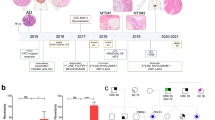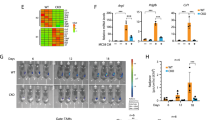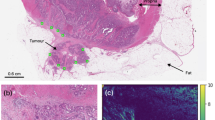Abstract
Matrix metalloproteinases play a crucial role in tumour invasion and mestasis. Matrilysin (MMP-7) has been shown to correlate with nodal or distant metastasis in colorectal carcinomas; however, its implication in early invasive colorectal carcinomas has not been determined. This study was undertaken to clarify the association of matrilysin expression with clinicopathologic parameters in early invasive colorectal carcinomas. 38 early invasive colorectal carcinomas treated by local excision or radical surgery were examined. Tumour budding was evaluated as the number of dedifferentiation units along the entire invasive margin. Matrilysin protein levels were determined using immunohistochemical study. Univariate analysis showed that matrilysin expression alone was significantly associated with distant metastasis (P= 0.0339), and both tumour budding and matrilysin expression were significantly associated with adverse outcome (P= 0.0005, 0.0341). Histological differentiation, vessel invasion, and depth of invasion were not significantly associated with either distant metastasis or adverse outcome. Multivariate analysis confirmed that tumour budding and matrilysin expression were independently associated with adverse outcome, although the significance of matrilysin expression was marginal (P= 0.0488). Tumour budding at the invasive margin and matrilysin expression are more useful in identifying high-risk groups for adverse outcome in patients with early invasive colorectal carcinomas. © 2001 Cancer Research Campaign
Similar content being viewed by others
Article PDF
Change history
16 November 2011
This paper was modified 12 months after initial publication to switch to Creative Commons licence terms, as noted at publication
References
Adachi Y, Itoh F, Yamamoto H, Matsuno K, Arimura Y, Kusano M, Endo T Hinoda Y, Oohara M, Hosokawa M and Imai K (1998) Matrix metalloproteinase matrilysin (MMP-7) participates in the progression of human gastric and esophageal cancers. Int J Oncol 13: 1031–1035
Adachi Y, Yamamoto H, Itoh F, Hinoda Y, Okada Y and Imai K (1999) Contribution of matrilysin (MMP-7) to the metastatic pathway of human colorectal cancers. Gut 45: 252–258
Babletz T, Jung A, Dag S, Hlubek F and Kirchner T (1999) β-catenin regulates the expression of the matrix metalloproteinase-7 in human colorectal cancer. Am J Pathol 155: 1033–1038
Christie JP (1988) Polypectomy or colectomy? Management of 106 consecutively encountered colorectal polyps. Am Surg 54: 93–99
Colacchio TA, Forde KA and Scantlebury VP (1981) Endoscopic polypectomy: inadequate treatment for invasive colorectal carcinoma. Ann Surg 194: 704–707
Cooper HS (1983) Surgical pathology of endoscopically removed malignant polyps of the colon and rectum. Am J Surg Pathol 7: 613–623
Cranley JP, Petras RE, Carey WD, Paradis K and Sivak MV (1986) When is endoscopic polypectomy adequate therapy for colonic polyps containing invasive carcinoma?. Gastroenterology 91: 419–427
Crawford HC and Matrisian LM (1995) Tumor and stromal expression of matrix metalloproteinases and their role in tumor progression. Invasion Metastasis 14: 234–245
Furusawa M (1985) Prognosis of patients with colon cancer limited to submucosal layer, who had undergone endoscopic polypectomy. Stomach Intestine 20: 1087–1094, (in Japanese with English abstract)
Haggitt RC, Glotzbach RE, Soffer EE and Wruble LD (1985) Prognostic factors in colorectal carcinomas arising in adenomas: implications for lesions removed by endoscopic polypectomy. Gastroenterology 89: 328–336
Hase K, Shatney C, Johnson D, Trollope M and Vierra M (1993) Prognostic value of tumor “budding” in patients with colorectal cancer. Dis Colon Rectum 36: 627–635
Masaki T and Muto T (2000) Predictive value of histology at the invasive margin in the prognosis of early invasive colorectal carcinoma. J Gastroenterol 35: 195–200
Miyazaki K, Hattori Y, Umenishi F, Yasumitsu H and Umeda M (1990) Purification and characterization of extracellular matrix-degrading metalloproteinases, matrin (Pump-1), secreted from human rectal carcinoma cell line. Cancer Res 50: 7758–7764
Morson BC, Bussey HJR and Samoorian S (1977) Policy of local excision for early cancer of the colorectum. Gut 18: 1045–1050
Morson BC, Whiteway JE, Jones EA, Macrae FA and Williams CB (1984) Histopathology and prognosis of malignant colorectal polyps treated by endoscopic polypectomy. Gut 25: 437–444
Muto T, Sawada T and Sugihara K (1991) Treatment of carcinoma in adenomas. World J Surg 15: 35–40
Ono M, Sakamoto M, Ino Y, Moriya Y, Sugihara K, Muto T and Hirohashi S (1996) Cancer cell morphology at the invasive front and expression of cell adhesion-related carbohydrate in the primary lesion of patients with colorectal carcinoma with liver metastasis. Cancer 78: 1179–1186
Stetler-Stevenson WAG, Aznavoorian S and Liotta LA (1993) Tumor cell interactions with the extracellular matrix during invasion and metastasis. Ann Rev Cell Biol 9: 541–573
Wilson CL and Matrisian LM (1996) Matrilysin: an epithelial matrix metalloproteinase with potentially novel functions. Int J Biochem Cell Biol 28: 123–136
Woessner JF Jr and Taplin C (1988) Purification and properties of a small latent matrix metalloproteinase of the rat uterus. J Biol Chem 263: 16918–16925
Yamamoto H, Itoh F, Adachi Y, Sakamoto H, Adachi M, Hinoda Y and Imai K (1997) Relation of enhanced secretion of active matrix metalloproteinases with tumour spread in human hepatocellular carcinoma. Gastroenterology 112: 1271–1277
Yamamoto H, Adachi Y, Itoh F, Iku S, Matsuno K, Kusano M, Arimura Y, Endo T, Hinoda Y, Hosokawa M and Imai K (1999) Association of Matrilysin expression with recurrence and poor prognosis in human esophageal squamous cell carcinoma. Cancer Res 59: 3313–3316
Yamashita K, Azumano I, Mai M and Okada Y (1998) Expression and tissue localization of matrix metalloproteinase 7 (matrilysin) in human gastric carcinomas. Implications for vessel invasion and metastasis. Int J Cancer 79: 187–194
Author information
Authors and Affiliations
Rights and permissions
From twelve months after its original publication, this work is licensed under the Creative Commons Attribution-NonCommercial-Share Alike 3.0 Unported License. To view a copy of this license, visit http://creativecommons.org/licenses/by-nc-sa/3.0/
About this article
Cite this article
Masaki, T., Matsuoka, H., Sugiyama, M. et al. Matrilysin (MMP-7) as a significant determinant of malignant potential of early invasive colorectal carcinomas. Br J Cancer 84, 1317–1321 (2001). https://doi.org/10.1054/bjoc.2001.1790
Received:
Revised:
Accepted:
Published:
Issue date:
DOI: https://doi.org/10.1054/bjoc.2001.1790
Keywords
This article is cited by
-
Serum matrix metalloproteinase-7: a potential biomarker in patients with Lynch Syndrome
Molecular Biology Reports (2023)
-
Serum MMP7, MMP10 and MMP12 level as negative prognostic markers in colon cancer patients
BMC Cancer (2016)
-
NOX1 to NOX2 switch deactivates AMPK and induces invasive phenotype in colon cancer cells through overexpression of MMP-7
Molecular Cancer (2015)
-
Knockdown of MMP-7 inhibits cell proliferation and enhances sensitivity to 5-fluorouracil and X-ray irradiation in colon cancer cells
Clinical and Experimental Medicine (2014)
-
Matrix metalloproteinases in cancer: their value as diagnostic and prognostic markers and therapeutic targets
Tumor Biology (2013)



